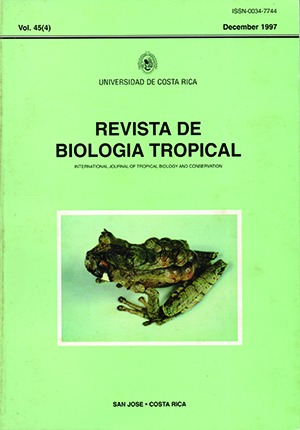Resumen
La actividad de reproducción de Dendrobates pumilío fue observado en La Reserva Biológica Hitoy Cerere, Costa Rica de julio a diciembre 1993. La actividad diaria de canto era mayor por la mañana entre las 8.00 y 10.00 hrs, se mantuvo desde julio a octubre, pero fue declinando en noviembre y diciembre. En septiembre y octubre la actividad de apareamiento era mayor e, igual que el canto, bajó considerablemente hasta finales del año. El número de los machos que cantaron y la actividad de apareamien to fueron influidos positivamente por la precipitación. La actividad diaria de un macho territorial reveló que el forrajeo se realiza durante la actividad de canto y el control del territorio mientras no era compatible con el cortejo.##plugins.facebook.comentarios##

Esta obra está bajo una licencia internacional Creative Commons Atribución 4.0.
Derechos de autor 1997 Revista de Biología Tropical
Descargas
Los datos de descargas todavía no están disponibles.


